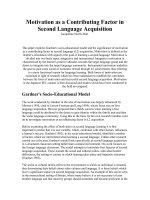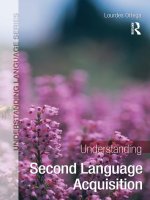Understanding Second Language Acquisition by Rod Ellis
Bạn đang xem bản rút gọn của tài liệu. Xem và tải ngay bản đầy đủ của tài liệu tại đây (328.89 KB, 20 trang )
Chapter 4
The development of a second language
Presenter 1: Lý Thiện Bình
The development of a second language
1. Order of acquisition, sequence of acquisition, and usage- based accounts of L2
development
2. Case studies of L2 learners
3. Learner varieties
Order of acquisition
◦To investigate when learners achieve mastery of different linguistic or pragmatic features
◦‘My father live in London’ - the use of third-person –s has not been supplied.
⇒no mastery
◦‘My father lives in London’, the use of third-person –s has been correctly supplied.
⇒ mastery
Ellis R. (1985). Understanding second language acquisition. Oxford University Press.
Sequence of acquisition
◦Evidence of the learner progressing from an early stage to a later one
◦‘No coming today’ -> ‘I don’t coming today’.
⇒syntactic features are acquired gradually
Ellis R. (1985). Understanding second language acquisition. Oxford University Press.
Usage-based accounts of learning
◦Learners gradually and dynamically move from chunks to constructions
◦‘Good morning
⇒Good afternoon/evening
Ellis R. (1985). Understanding second language acquisition. Oxford University Press.
Case studies of L2 learners
Schmidt’s (1983) study of Wes
◦Wes was a 33-year-old Japanese learner of L2 English who left school at the age of fifteen
◦The focus of Schmidt’s study was the extent to which Wes’s acculturation to American society could explain his
development of communicative competence
(1) linguistic competence (i.e. the ability to use grammatical structures with target-like accuracy)
(2) sociolinguistic competence (i.e. the ability to use language in socially appropriate ways)
(3) discourse competence (i.e. the ability to participate in coherent and cohesive conversations)
(4) strategic competence (i.e. the ability to deal with communication breakdown)
Case studies of L2 learners
Schmidt’s (1983) study of Wes
Findings
◦The development of these abilities proceeded separately.
◦Wes’s linguistic competence remained quite limited.
◦There was greater evidence of development in his sociolinguistic competence.
◦The aspect that showed the greatest development was Wes’s discourse competence.
◦Wes also manifested considerable strategic competence.
Case studies of L2 learners
Schmidt’s (1983) study of Wes
Conclusion
◦First, it showed the partial independence of grammatical competence from other aspects of communicative
competence.
◦Second, the lack of linguistic development could not be explained by Wes’s failure to acculturate as in fact
he became socially very integrated when he lived in Hawaii.
Case studies of L2 learners
R. Ellis’s (1984, 1992) study of two classroom learners
◦There were three learners, all children aged ten to 13 years, and all complete beginners at the start of the
study.
◦The researcher focused on their communicative speech
◦The purpose was to examine whether the pattern of development evident in these classroom learners was
the same as or different from the pattern reported for naturalistic learners / whether the instructional
setting influenced the way in which the children learned English.
Case studies of L2 learners
R. Ellis’s (1984, 1992) study of two classroom learners
Findings
Learners’ linguistic development
◦Three children made extensive use of formulaic sequences as a means of performing the communicative
acts
◦Over time, the learners were able to modify and extend these formulas.
◦‘I don’t know’ -> ‘I don’t understand’-> ‘You don’t know’ -> ‘I don’t know this one’
◦‘Semantic simplification’ diminished in the children’s speech over time
◦‘Sir, sir, pencil’ - meaning ‘You have taken my pencil’
Case studies of L2 learners
R. Ellis’s (1984, 1992) study of two classroom learners
Findings
The sequence of acquisition for negatives and interrogatives
◦The developmental profiles for these structures of the three children were very similar to each other and
showed a striking similarity to that reported for naturalistic learners.
◦‘No’ -> ‘No’ + verb negatives -> negatives with auxiliaries (don’t)
Case studies of L2 learners
R. Ellis’s (1984, 1992) study of two classroom learners
Findings
Development in a pragmatic feature (requests)
◦The range of request types expanded
◦Direct request -> ‘could’ -> ‘Could you ...’
◦The learners’ requests continued to be of the direct kind, more complex types of requests did not occur at
all, and the range of formal devices for encoding requests remained limited
◦No evidence of the learners systematically modifying their choice of request strategy according to
addressee
Case studies of L2 learners
R. Ellis’s (1984, 1992) study of two classroom learners
Conclusions
◦These learners relied initially on formulaic chunks to express their communicative needs and gradually learned
how to manipulate the linguistic elements in these chunks to produce more varied, novel utterances
◦The general pattern of development was very similar to naturalistic learners, suggesting that the classroom
setting did not have a major effect on how these learners’ linguistic competence developed.
◦After two years, their development was still quite limited - the classroom setting did not afford the appropriate
communicative conditions for acquisition / L2 development is a slow and gradual process
Case studies of L2 learners
Jia and Fuse’s (2007) study of Chinese ESL learners
◦The study investigated the acquisition of
English grammatical morphemes (regular and irregular past
tense, third-person singular -s, verb + - ing, copula be, and auxiliary do )
◦There were ten learners in this study - They all received focused ESL instruction for a period of time - two
groups—six who were early arrivals and four who were late arrivals.
Case studies of L2 learners
Jia and Fuse’s (2007) study of Chinese ESL learners
Main findings
◦The two easiest structures were progressive - ing and auxiliary ‘do’ and the two most difficult were regular past
tense and third-person -s.
◦The age of arrival of the learners had no effect on the order of acquisition.
◦Progressive - ing and plural -s, for example, showed accelerated learning initially and then levelled off.
◦In contrast, third-person -s was acquired slowly but steadily with no plateauing
◦Regular past tense showed no significant growth over time, but with fluctuations from one point in time to the
next.
Case studies of L2 learners
Jia and Fuse’s (2007) study of Chinese ESL learners
Conclusion
◦Learners learn features that are more frequent and/or more salient earlier than those features that are less
frequent and/or less salient.
◦They explained the advantage noted for the early arrivals in terms of the richer learning environment they
experienced.
Case studies of L2 learners
Some general observations
1.For some learners, little grammatical development appears to take place.
2. L2 development is uneven.
3. Grammatical development is not linear
4. Learners’ early attempts to use the L2 are characterized by structural and semantic simplification.
5. The learners made extensive use of formulaic expressions to communicate and that these were prevalent in the early stages.
6.Learners appear to acquire grammatical morphemes in a relatively fixed order irrespective of the age of the learners.
7.There is also evidence of sequences of acquisition; grammatical features and pragmatic features are acquired gradually
8. Various factors can contribute to considerable differences —the learner’s first language, the learner’s age, and the richness of the learner’s
learning environment.
Learner varieties
Ellis R. (1985). Understanding second language acquisition. Oxford University Press.
Learner varieties
Ellis R. (1985). Understanding second language acquisition. Oxford University Press.
Reference
◦ Ellis, R. (1984). Classroom Second Language Development. Oxford: Pergamon.
◦ Ellis R. (1985). Understanding second language acquisition. Oxford University Press.
◦ Ellis, R. (1992). ‘Learning to communicate in the classroom’. Studies in Second Language Acquisition 14: 1–23.
◦ Jia, G. and A. Fuse. (2007). ‘Acquisition of English grammatical morphology by native mandarin-speaking children and
adolescents: age-related differences’. Journal of Speech, Language and Hearing Research 50: 1280–99.
◦ Schmidt, R. (1983). ‘Interaction, acculturation and the acquisition of communication competence’ in Wolfson, M. and E. Judd
(eds.): Sociolinguistics and Second Language Acquisition. Rowley, MA: Newbury House.









